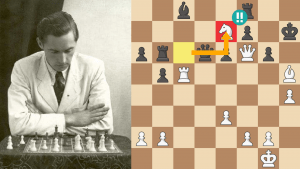
Light Squares And Black's Magical a-Pawn
I’ve written several articles that discuss the dynamics of chess teacher and student, and the kinds of things a student should expect from lessons. Though the teacher will give his charge a study program, there is nothing more useful and instructive than having the student annotate his own games (WITHOUT using a chess engine! I want to see what the student thinks went right or wrong, not what the computer thinks), and then go over that game and notes with the teacher.
After going over the game together, I will give him a copy of that same game, though this time it would have my notes. And finally, I would add several master games (with no notes) that show more examples of the pawn structure and typical tactics in those kinds of positions.
If you want a taste of this, annotate this game yourself (looking for best play for both sides). Afterwards, take a look at my notes. And then play over the master games I’ve added so you can see how effective our highlighted Black strategy can be.
MAKE YOUR OWN NOTES
1.e4 e6 2.d3 d5 3.Nd2 Nf6 4.Ngf3 Nc6 5.g3 dxe4 6.dxe4 Bc5 7.Bg2 e5 8.0-0 0-0 9.c3 a5 10.Qc2 Be6 11.Ng5 Qe7 12.Nxe6 Qxe6 13.Nf3 Nd7 14.Ng5 Qe7 15.Bh3 h6 16.Nf3 Nd8 17.Nh4 Ne6 18.Nf5 Qf6 19.Be3 Kh7 20.Qe2 Ng5 21.Bxg5 hxg5 22.Qh5+ Kg8 23.Nxg7 Kxg7 24.Bxd7 and Black eventually lost.
SAME GAME WITH MY NOTES
So far, all theory!
White’s key squares here are c4 (a nice home for a knight), d5, f5, and e3 (a knight on e3 takes aim at c4, d5, and f5!). White’s usual plan is to get the f3-knight to f5 (If Black takes on f5 then exf5 gives White the two bishops and also opens up the h1-a8 diagonal for White’s light-squared bishop.), the d2-knight to e3, the h2-pawn to h4 (in many cases) with kingside attacking chances.
I also think that it’s wise for White to play a2-a4, stopping Black’s a-pawn in its tracks and giving White a chance to (eventually) claim the c4-square for his own.
Black needs to challenge the central and queenside light-squares. He can do this with ...Be6 (hitting c4), or (after ...b7-b6) ...Ba6. One ideal setup is to push the f7-pawn to f6 (keeping White’s pieces off of g5 and also protecting e5), place the light-squared bishop on e6, push the a5-pawn to a4 (preventing a2-a4 and fixing the a2-pawn, which becomes a target to the e6-bishop.
Note that, if that occurs, pushing the a2-pawn to a3 would leave a gaping hole on b3), and place Black’s other queenside pawns on b5 (defending a4 and hitting c4) and c6 (defending b5 and keeping White’s pieces off of d5).

Notice how, after a2-a4, Black’s c6-knight can’t move forward. However, if White allows ...a5-a4 then the c6-knight can, at some point, move to a5, challenging the light-squares on c4 and b3.
Of course, the plans listed here are lovely dreams, but a well-schooled opponent will do his best to prevent those dreams from happening, or he’ll allow the opponent’s dream as long as he gets to create his own.
Clearly, if you aren’t familiar with those plans, you won’t be able to make use of them; nor will you be able to prevent your opponent from creating these ideal setups.
THEMATIC PLAN FOR BLACK
OTHER EXAMPLES OF THE LIGHT-SQUARE STRATEGY USING ...a7-a5-a4






